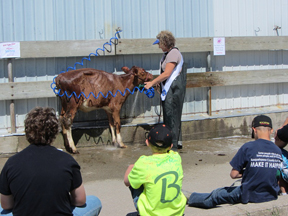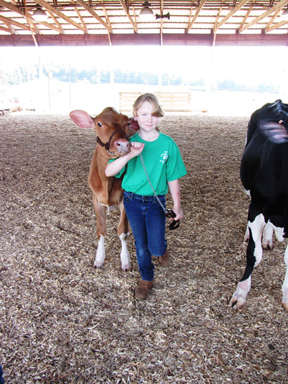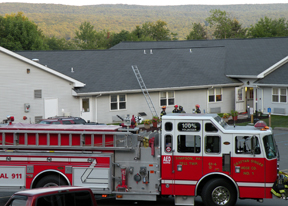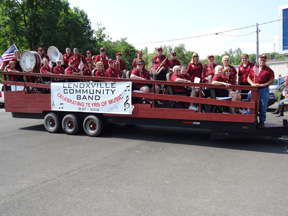The Susquehanna County 4-H Dairy Leaders and Penn State Cooperative Extension in Susquehanna County recently organized a two-day, overnight camp for sixty-two 4-H dairy club members from Susquehanna, Wyoming, and Wayne Counties on Wednesday, June 27th and Thursday, June 28th at the Harford Fairgrounds. Dairy Camp is a longtime tradition here in Susquehanna County for 4-H members to learn a variety of topics relating to their 4-H dairy projects and to have a little fun too!

4-H Leader Cathy Bewley instructing 4-H Dairy members the proper techniques for washing their project animals

Katelyn Supancik leading her calf
The fifty-seven 4-H members were divided into teams, all named after forages that dairy cattle eat – Legumes, Hay, Silage, Green Chop, Baleage, and Corn. Senior 4-H members: Alex Bonavita, Doug Brooks, Evan Castrogiovanni, Sabrina Clark, Kennidy Finch, Cassidy Greenwood, Devon Greenwood, Kenzie Jones, Keri Jones, Abbey Hirkey, Allison Kiefer, Emma Loch, Carly Sherwood, Emily Supancik, Jamie Supancik, Mariah Tompkins, and Trevor Tompkins served as team captains to keep 4-Hers organized and to help the camp run smoothly. Rachel Smarkusky, Susquehanna County 4-H Summer Assistant and Amanda Hirkey, Wyoming County 4-H Summer Assistant also assisted in organizing and conducting the camp.
4-H members, leaders, and parents had the opportunity to attend a variety of educational workshops on Wednesday to kickoff Dairy Camp. The six workshops included How to wash my dairy heifer by Cathy Bewley, Susquehanna; Dairy Showmanship presented by Jenna Sprout, Montrose; Dairy Fitting lead by Mike Greenwood, Montrose.; How do you ID your animal presented by Rachel Smarkusky, Nicholson and Amanda Hirkey, Meshoppen; How do I keep records and properly store medications presented by Amberleigh Packard, Towanda and Amanda Hunt, Towanda; and Dairy Trivia by Susquehanna County Dairy Promotions Court. Wednesday afternoon the 4-Hers worked with their partners selecting, training, and clipping a dairy heifer for the mock showmanship and fitting contest held on Thursday morning. 4-H members practiced the 4-H slogan, “Learning by Doing” while working hands-on with a dairy heifer to develop their showmanship and fitting skills under the guidance of older members, adults, and leaders who attended the Camp. The animals were graciously provided by the Pavelski and Bewley Families of Susquehanna.
On Thursday morning members had to opportunity to show off their talents in the mock showmanship and fitting contest. The showmanship contest was judged by Bryan Castrogiovanni, Montrose and the fitting contest was judged by Abby Onyon, New Milford.
Dairy Camp is one of the many 4-H activities offered in Susquehanna County. For more information about the 4-H program in Susquehanna County, please contact Penn State Cooperative Extension at 570-278-1158.
On Wednesday, July 18 the Forest City Nursing & Rehab Center conducted its annual disaster drill. Each year area fire fighters and first responders work with the area care facility to practice evacuation and set up drills in the event of an actual emergency. This year equipment and volunteers from Forest City Ambulance and Fire Company, Browndale Fire Company and the Grattan-Singer Hose Company of Simpson participated in the drill.

Forest City and Grattan-Singer Hose Companies practice emergency procedures at the Forest City Nursing Center
The disaster drill gives the volunteers a chance to sharpen their skills, and educates nursing home employees and residents on how to respond in a crisis.
The Lenoxville Community Band started as a take off of the Clarks Summit Community Band, in 1937. The local residents taught themselves how to play their favorite instrument until they could perform.
This newly formed band survived a recession, World War II, and even the influx of high school marching bands. As years passed many members grew weary and in 1978 a few clever members designed and built what is now the Lenoxville Band Wagon, our music on wheels.
Our organization has performed all through Pennsylvania, New York State and even has received many awards and honors including playing in the Rotunda in Harrisburg twice. The Lenoxville Community Band enjoys the many parades through the summer, but prefers concerts at the local fairs. In 1939 we first performed as the main entertainment at the Harford Fair and have been privileged to be a part of this fair every year since, even participating in "on ground" parades. Our many thanks for all these memories and always making us feel welcome.
The year of 1939 was memorable, also, for us to be invited to Tunkhannock for the Wyoming County Fair to entertain at the old fair grounds, across from the present Walmart. When the Kiwanis Wyoming County Fair moved to its location in Meshoppen, we were asked, once again, to perform and have been honored to be a part of their fair every year since. Thank you for supporting The Lenoxville Community Band, and to help us celebrate our 75th year of entertaining the public.

The Lenoxville Community Band celebrating 75 years of music
The Rail-Trail Council of NE PA would like to remind trail users that the D&H Rail-Trail from Simpson to the New York border above Lanesboro is closed to all motorized vehicles including ATV and dirt bike use. The O&W Rail-Trail from Simpson to Stillwater also prohibits all motorized use. The only area that allows ATV use is from Stillwater (across from parking lot) to Poyntelle. Trail pass information can be obtained from the Orson Inn.
State conservation officers and private patrols are enforcing these rules and tickets will be written out to offenders. Fines may be in the hundreds of dollars per each violation with additional court cost fees.
Trail users are asked to call the rail-trail office with information about reoccurring motorized use. The Rail-Trail Council will issue trespass complaints through the local magistrates and district attorney. Call 679-9300.
Please keep off the trails with any motorized vehicles. Parents, please remind your children that ATVs and dirt bikes are not allowed on the rail-trails.
UNIVERSITY PARK, Pa. - Ownership of the land in Pennsylvania counties with the most Marcellus Shale natural-gas drilling activity is concentrated among relatively few residents and people living outside the counties, according to a study by researchers in Penn State's College of Agricultural Sciences.
The majority of residents in these counties together own little of the total land area and, therefore, have relatively little "voice" in the critical leasing decisions that affect whether and how Marcellus Shale drilling will occur in the counties, noted the lead investigator Timothy Kelsey, professor of agricultural economics.
Together, half of the resident landowners in these counties control only about 1 percent of the land area, and renters have no "voice" at all, the study suggests. Rather it is the top 10 percent of resident landowners, plus outside landowners (both public and private), who are able to make the major leasing decisions that affect communities.
"In some counties, such as Sullivan, Tioga and Lycoming, nonresidents have more voice about what occurs than do county residents, because more than half of the land is owned by those outside the county," Kelsey said.
"Our analysis indicates that a majority of lease and royalty income from Marcellus Shale development will go to a relatively small share of the resident population in these counties, with much of the remainder going to others outside the counties."
The study, "Marcellus Shale: Land Ownership, Local Voice, and the Distribution of Lease and Royalty Dollars," was done by Penn State's Center For Economic and Community Development, which is housed in the College of the Agricultural Sciences.
Co-authored by Alex Metcalf, a post-doctoral scholar in forest resources, and Rodrigo Salcedo, a doctoral candidate in agricultural, environmental, and regional economics, the research was entirely funded by the University.
Penn State researchers felt it was important to look at the ownership of the land within 11 Pennsylvania counties with Marcellus natural-gas development activity because land ownership determines who has a voice in decisions about the activity and for the distribution of lease and royalty dollars, Kelsey explained.
"Much of the public debate about Marcellus Shale development revolves around differing views of fairness and equity," he said. "These discussions often focus on the environmental, health, and other risks, the proper role for local government regulation and oversight of industry activities, and the ability of individual owners to use their resources as they believe is appropriate."
The study was not intended to evaluate or make judgments about Act 13 of 2012 -- the state law that allows counties to decide whether to allow Marcellus drilling and to impose an impact fee on wells -- or the current distribution of control and income, Kelsey stressed.
"Rather, we believe that understanding land-ownership patterns helps to clarify the economic implications of Marcellus Shale development and the context for the concerns some are expressing about the need for more local government control over that development." he said.
To examine likely mineral-rights ownership, researchers collected publicly available geographic information system, or GIS, landownership data from 11 county planning offices. Counties included in the study are Bradford, Butler, Clearfield, Fayette, Greene, Lycoming, Sullivan, Tioga, Washington, Westmoreland and Wyoming.
The 11 counties include nine of the top 10 Marcellus counties in Pennsylvania; the sole missing top-10 county was Susquehanna, for which GIS information was unavailable. Together, the 11 counties account for 79 percent of all Pennsylvania Marcellus wells through 2011.
Because surface land owners in Pennsylvania do not necessarily own the mineral rights under their land, and because up to a fifth of the land in the counties in question is publicly owned (state forest and state game lands), researchers supplemented the GIS data with U.S. Census data, mailing address records and physical inspections of property records.
The county resident land ownership included a mix of individuals, families, local businesses, farmers, hunting camps, land trusts and others.
Kelsey said the research is important because it documents that many of the residents in the counties with much drilling activity don't have a voice in Marcellus development, despite having to deal with considerable disruption and change in their communities.
"They are encountering rising rents and housing prices, housing shortages, significant increases in traffic and road congestion, changing demands for local government services, increased conflict, concerns about environmental consequences, student turnover in public schools, and changes in the landscape," he said.
"The decisions by nonresident owners and by the relatively small share of residents who own the majority of land thus can have profound implications for the quality of life for everyone else in the community."


















